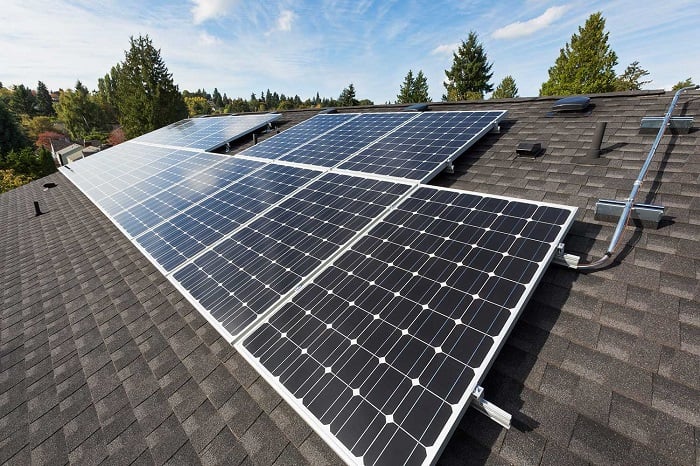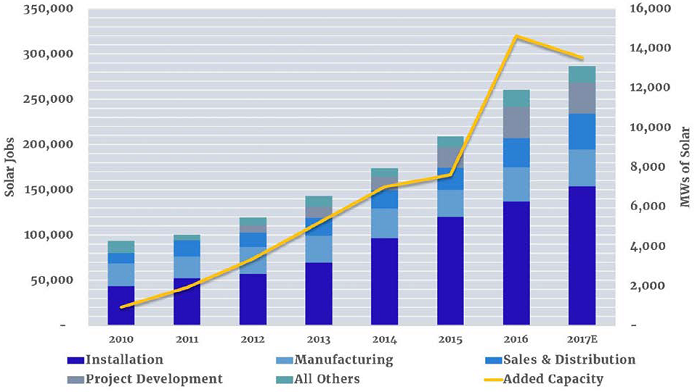The California Energy Commission (CEC) recently voted unanimously to require all new homes, multi-family residences of three stories or fewer, and all major renovations be constructed with solar panels starting January 1, 2020. The new building standards focus on four areas:
- Smart residential photovoltaic systems
- Updated thermal envelope standards
- Residential and nonresidential ventilation requirements
- Nonresidential lighting requirements
This is the first statewide solar mandate in the nation and furthers California's efforts to lead the U.S. in dramatically reducing greenhouse gas emissions.
"There are two things we must look at when we set standards," said Amber Beck, Public Information Officer for the California Energy Commission. "Is this technologically feasible and is it cost effective?"
The majority of negative responses reference the added costs to build a house, in a market already riddled with record high home prices. Projections suggest at least a $9,500 increase in the cost of building a solar equipped home, adding an extra $40 to a monthly payment. The CEC, however, estimates the extra cost will be offset by the overall savings, roughly $80 per month, when factoring in the combined lower energy costs produced by the new standards.
May the labor force be with you
Although there are no concrete numbers showing the state will have the skilled labor force needed, and California has experienced labor shortages in the past, solar energy advocates believe the state will have the workforce needed to meet the mandate.
“California’s new solar building requirements will create thousands of new jobs on top of the 85,000 solar workers currently employed in the state,” said Dan Whitten, Vice President of Communications at the Solar Energy Industries Association. “No question, there will be plenty of workers to provide every new home with clean and affordable solar power.”
In contrast, when several major solar industry employers were surveyed by The Solar Foundation for the 2017 Solar Jobs Census, 84% of solar installers reported they had “difficulty” finding qualified applicants and 26% reported they had “great difficulty.”
In response, The Solar Foundation, funded by the U.S. Department of Energy’s Solar Energy Technologies Office, announced in July 2018 that their Solar Training Network will offer the solar industry a new toolkit to help them meet the growing demand.

“Solar companies are struggling to find qualified workers in the wake of the industry’s rapid expansion over the past decade,” said Andrea Luecke, President and Executive Director of The Solar Foundation. “Our research also shows that training opportunities are not well coordinated with industry needs in many regional markets. This new toolkit is a step-by-step guide for engaging workforce development resources, positioning the industry for stronger future growth.”
Businesses with a foothold stand to benefit
Most likely, entrenched construction, solar and roofing operations with established networks for combining roofing and solar installations will benefit most from the mandate, as well as solar-related companies with in-house, cross-training programs. Those companies that have invested in outside classes, such as through a community college, will also have a leg up on the competition as the graying workforce, including electricians, continues to retire.
Every solar panel installation must have an electrician and the Bureau of Labor Statistics (BLS) predicts employment of electricians to increase by 20 percent through 2022, nearly double the average growth rate for all other jobs. That means as many as 114,700 new electricians will be needed to fill the gap. Both the International Brotherhood of Electrical Workers (IBEW) and the National Electrical Contractors Association(NECA) are promoting their own apprenticeship programs to boost the number of electricians over the coming years.

What you need to know about solar panels?
At first glance solar power may seem simple; however, multiple factors can complicate solar panel installation including the critical wiring and required electrical system, and safety oversight of each project.
To properly install solar panels, workers will need to understand some of the more complex processes, including a working knowledge of solar mechanics and equipment to ensure the components operate efficiently. Additionally, workers will need to know how to use installation and measuring tools, such as ammeters, voltmeters, thermal scanners, and cable testers, and troubleshoot power outputs, continuity and reasons for voltage drops.
While solar panels generally need little attention once installed, businesses will need solar panel experts to perform maintenance repairs, monitor solar panel and system performance, and make system upgrades as solar technology advances.
California - the nation's testing ground
With 3,200 hours of sunshine produced every year and an extensive array of support from organizations and solar companies, the future looks bright for the state. Installation costs continue to fall and solar companies are working hard to develop more efficient solar solutions and products. Will the capacity be there to meet the solar installation labor demands? Only time will tell, as other states watch carefully to see how and if California successfully carries out the mandate.
Solar statistics
- California is the largest producer of solar power in the nation – 40% to 45% of solar power
- California is the leading solar jobs employer - approximately 86,414
- The U.S. solar workforce grew 168 percent from 2010 at 93,000 workers to 250,262 in 2017
- Solar energy is the fastest-growing energy sector accounting for almost two-thirds of net new capacity worldwide
- China represents almost 50% of the total solar power generated in the world
- Solar voltaic installers represent the fastest growing occupation in the U.S. - expected to increase 105% from 2016 to 2026
- The U.S. Census Bureau estimates a 24% increase in the number of solar technician jobs in the US during the ten-year period leading up to 2024
Find out which tools PV experts recommend in the burgeoning solar energy industry